The Latin Neuter Plurals in Romance - Page ON
The Latin Neuter Plurals in Romance - Page ON
The Latin Neuter Plurals in Romance - Page ON
You also want an ePaper? Increase the reach of your titles
YUMPU automatically turns print PDFs into web optimized ePapers that Google loves.
113<br />
113<br />
FUNDUS, ARCUS, COLFUS, NODUS, GRADUS, PUTEUS, VADUS, FETUS — we f<strong>in</strong>d<br />
firstly Rum. pl. armuri (with a new s<strong>in</strong>g, armur(e) alongside arm), and ierburi<br />
‘herbs’, ‘small flower<strong>in</strong>g plants’ as the plural of iarbă ‘grass’, ‘herb’. Here<br />
Italian has no -ora forms for either, as far as I have been able to discover, unless<br />
the Lombard <strong>Lat<strong>in</strong></strong> gerboras (“<strong>in</strong>ter gerboras et terra arva”) is this word; ERVUS<br />
appears as lero or learned ervo (and note also the erbo quoted above), but we<br />
f<strong>in</strong>d erbor- or erbol- <strong>in</strong> derivatives of erba such as erborare, and I will discuss<br />
this <strong>in</strong> a m<strong>in</strong>ute. For FUNDUS we have Rum. pl. funduri and Lomb. Lat. fundora;<br />
I have not found such a form quoted from later writ<strong>in</strong>gs, but the extended stem<br />
is seen <strong>in</strong> OIt. sfondolare. In the case of ARCUS we have Rum. pl. arcuri as well<br />
as old arce, Lomb. Lat. arcora, with the same form cont<strong>in</strong>ued <strong>in</strong> Old Tuscan,<br />
and for COLFUS the modern Rum. golfuri, which happens to balance the<br />
COLFORA recorded at Ravenna. NODUS is represented by Rum. pl. noduri and<br />
adj. noduros, OTusc. nodora, Calab. nudura, adj. nodoruto (thus lend<strong>in</strong>g<br />
support to the idea of a neuter *NODUS surviv<strong>in</strong>g <strong>in</strong> Gallo-<strong>Romance</strong>), and<br />
GRADUS by Lomb. Lat. and OIt. gradora (Rum. grad, pl. grade, is modern). For<br />
PUTEUS we have Rum. pl. puŃuri, It. dial. pozzora, puzzure, for VADUS Rum. pl.<br />
vaduri and Lomb. Lat. vadora, and for FETUS Lomb. Lat., Neap. fetora (here<br />
Rumanian has masc. făt, pl. feŃi, as <strong>in</strong> Făt Frumos ‘Pr<strong>in</strong>ce Charm<strong>in</strong>g’).<br />
Elsewhere the extended stem of ARMUS is found <strong>in</strong> Sp. enarmorarse<br />
‘rear up’, and then we come to ERVUS, about which Meyer-Lübke has an<br />
<strong>in</strong>terest<strong>in</strong>g theory, though this is called <strong>in</strong>to question by Corom<strong>in</strong>as. His idea<br />
(already expressed <strong>in</strong> Schicks.) is that Rum. ierburi, It. erbor- are not org<strong>in</strong>ally<br />
connected with HERBA, but come from 3rd-declension ERVUS, attested <strong>in</strong><br />
Venantius Fortunatus and backed up by Fr., Prov., Cat. ers; Corom<strong>in</strong>as, however,<br />
argues that this last-named form has come from the plural, say<strong>in</strong>g that <strong>in</strong><br />
Spanish the pl. yeros is the form normally used. On the other hand, we f<strong>in</strong>d the<br />
root HERBOR- diffused everywhere, It. erbor-, erbol-, Fr. herbor-, herbol-, Prov.









